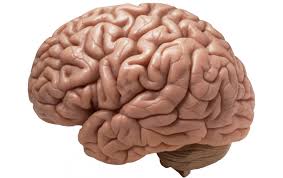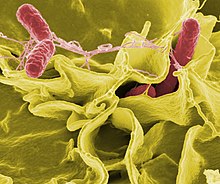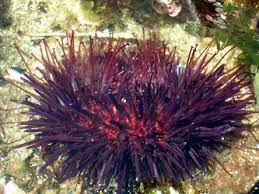Los Alamos researchers and scientists recently have designed a new type of nanostructured-carbon-based catalyst, which could be a start towards reliable, economical next-generation batteries and alkaline fuel cells, providing for practical use of wind and solar-powered electricity, as well as enhanced hybrid electric vehicles. Without using precious metals like platinum, which is more expensive per ounce than gold, it performs under certain conditions as effectively as many well-know and prohibitively expensive precious-metal catalysts developed for battery and fuel-cell use. Scientists have also demonstrated that the synthesis method can be scaled up to larger volumes and could also be used to prepare other carbon-nanotube-based materials.
NOS themes:
Science is based on evidence
Science is collaborative
The role of curiosity
http://www.sciencedaily.com/releases/2013/06/130604135452.htmf
Wednesday, June 5, 2013
Tuesday, June 4, 2013
Scientist discover way to make bio fuel cheaper
Scientist discover way to make bio fuel cheaper
Scientist have discovered a way to make fungi digest sawdust and various other material easier. This is a major step as the procedure cost a lot of money and contributes a lot to the cost of bio fuels. The reason the procedure is so expensive is due to the fact that the substance need to make the fungi digest the wood easier. The substance needed is called dissaccharide sophorose and it is 60 times more expesnive than gold. The scientist have managed to change the DNA of the fungus so that it always digest wood.
NOS themes
1.Science is based on evidence(the scientist had to make sure that the fungus disgested wood and that the genes were correct.)
2.Role of motivation and curiosity( the scientist had to be motivated to carry out this experiment)

Bio fuel made from elephant dung!
Link:http://www.biologynews.net/archives/2013/06/03/molecular_switch_for_cheaper_biofuel.html
NOS themes
1.Science is based on evidence(the scientist had to make sure that the fungus disgested wood and that the genes were correct.)
2.Role of motivation and curiosity( the scientist had to be motivated to carry out this experiment)

Bio fuel made from elephant dung!
Link:http://www.biologynews.net/archives/2013/06/03/molecular_switch_for_cheaper_biofuel.html
Emotional Apes
We, as humans, get emotional when it comes to decision making. If we make a bad decision, we get upset and occasioanlly throw a temper tantrum, and if we make a good decision we're ecstatic. Apes, when given the choice to gamble for the better food but faced with a not-so-yummy treat if they lost the gamble, acted the same way that humans do.
Both chimpanzees and bonobos, upon making the worse decision, threw tantrums and tried to change their decision. Some of the emotional responses were specific to the certain species, and some were specific to the individual animal.
http://www.sciencedaily.com/releases/2013/05/130529190933.htm
Themes of Nature and Science:
1.Science is based off of evidence
2.A person's view can infuence data
3. Role of motivation and curiosity
Both chimpanzees and bonobos, upon making the worse decision, threw tantrums and tried to change their decision. Some of the emotional responses were specific to the certain species, and some were specific to the individual animal.
http://www.sciencedaily.com/releases/2013/05/130529190933.htm
Themes of Nature and Science:
1.Science is based off of evidence
2.A person's view can infuence data
3. Role of motivation and curiosity
Monday, June 3, 2013
A Step Closer to Artificial Livers
http://www.sciencedaily.com/releases/2013/06/130602144612.htm
The human liver has some amazing regenerative properties. As much as a third of it can be removed, and it can regenerate to perfect function. Scientists have tried to make use of this for the growth of livers outside of the body for a long time, but for some reason, they liver cells would no longer reproduce outside of the body. Recently (yesterday), scientists published an article saying that they have now identified 12 different chemicals that make the liver cells continue to regenerate and grow outside of the body. This is a major step in the progress toward not only externally grown livers, but all externally grown organs.
Nature of science themes:
- Science is collaborative: Dr. Bhatia as well as a team of scientists from MIT discovered this, but their work was built on the work of the many scientists before them who were all trying to solve the same problem.
-Science is based on evidence: The liver cells in the new substances when put in a pitri dish were shown to start regenerating, unlike those in any other solutions or in no solution at all.
-Roll of motivation and curiosity: The students wouldn't have gone to MIT for medicinal research if they weren't interested. They also know that this will help a lot of people. Just to give an example, I heard that someone at EPHS recently had a liver transplant, and were very lucky to have gotten one. If this technology becomes successful in the future, getting a liver will never be a problem.
-Importance of repeatability: Obviously if this can't be repeated, then the experiment is useless, as the end goal is the have a reliable way to generate organs for people who need transplants.

Cameron Kurisko
The human liver has some amazing regenerative properties. As much as a third of it can be removed, and it can regenerate to perfect function. Scientists have tried to make use of this for the growth of livers outside of the body for a long time, but for some reason, they liver cells would no longer reproduce outside of the body. Recently (yesterday), scientists published an article saying that they have now identified 12 different chemicals that make the liver cells continue to regenerate and grow outside of the body. This is a major step in the progress toward not only externally grown livers, but all externally grown organs.
Nature of science themes:
- Science is collaborative: Dr. Bhatia as well as a team of scientists from MIT discovered this, but their work was built on the work of the many scientists before them who were all trying to solve the same problem.
-Science is based on evidence: The liver cells in the new substances when put in a pitri dish were shown to start regenerating, unlike those in any other solutions or in no solution at all.
-Roll of motivation and curiosity: The students wouldn't have gone to MIT for medicinal research if they weren't interested. They also know that this will help a lot of people. Just to give an example, I heard that someone at EPHS recently had a liver transplant, and were very lucky to have gotten one. If this technology becomes successful in the future, getting a liver will never be a problem.
-Importance of repeatability: Obviously if this can't be repeated, then the experiment is useless, as the end goal is the have a reliable way to generate organs for people who need transplants.

Cameron Kurisko
Cicadas are loud!
Cicadas are loud!
Cicadas are a type of bug that live almost their whole life under the ground, they grow underground and after 17 years they come out and produce a very loud mating call that reaches up to 100 decibels, they mate and then they die leaving cicada larvae underground, who wait for 17 more years until they come out again and the cycle restarts.
The US navy has been investigating the sounds that Cicadas make to find out how they can use the way in which the cicadas make this high sound in their own advantage.
The cicadas make that sound with a very small part of their throat, so the navy wants to find out how they can created so much noise with a very small device to use it for their own advantage
It is still not fully understood how cicada make that noise but it is also thought they make it with air sacks they blow.
It is important to find out how different animals do things because this way we can apply it to our own lives and technology, and that way advance more as
humans. We might find very helpful things in finding examples from what nature shows us.
NOS themes.
the role of motivation and curiosity
New One-Step Process for Designer Bacteria
Researchers at the University of Adelaide have discovered a new one-step process for DNA replication. The call this process "Clonetegration." As we all know, you can use bacteria to produce several substances that are hard to get otherwise by inserting the required gene(s) into its chromosome. The bacteria will then start producing the substance as if it was made to do it all along. The current process, however, is very inefficient and could take several days to complete the process, and is also a bit more expensive. The new method could complete the process overnight, and can be put into the organism multiple times allowing for increased production. Due to the fact that this is still in development, the researchers have yet to release the process out to the public, which is rather unfortunate.
NOS themes
-Motivation and Curiosity for advancement
-Scientific Collaboration
http://www.biologynews.net/archives/2013/05/28/new_1step_process_for_designer_bacteria.html
-
Forgetting is Harder for Older Brains

It may sound weird at first, but older people actually retain memories for much longer. This is due to an abundance of a protein that resists the breaking of synapses between nervous cells. A study on mice supported this because they found a large amount of the protein NR2A on the neurons of the older mice and this has been known to increase in abundance with age. The study also showed that when something "slips your mind," it was actually intentional because there is also a protein that dissolves synapses.
NOS themes
-supported by evidence
-several scientists working together
http://www.scientificamerican.com/article.cfm?id=forgetting-is-harder-for-older-brains
Sunday, June 2, 2013
Honey Bee Navigation
 Researchers have found that in honey bees there is a regulatory gene, called Egr, that is involved in learning. This gene is also present in vertebrates. In honey bees it becomes active whenever they are in a new place and have to figure out how to find their way around. It was definitely not associated with exercise or visual cues; the researchers saw that the Egr activity occurred only when the bees were in new environments. Because they now know this, researchers may be able to understand just how the honey bees are able to navigate so well. Not only that, but the fact that the gene is also present and important to vertebrates is a good example of how behavioral relationships are "deeply conserved" in evolution.
Researchers have found that in honey bees there is a regulatory gene, called Egr, that is involved in learning. This gene is also present in vertebrates. In honey bees it becomes active whenever they are in a new place and have to figure out how to find their way around. It was definitely not associated with exercise or visual cues; the researchers saw that the Egr activity occurred only when the bees were in new environments. Because they now know this, researchers may be able to understand just how the honey bees are able to navigate so well. Not only that, but the fact that the gene is also present and important to vertebrates is a good example of how behavioral relationships are "deeply conserved" in evolution.Nature of Science
Science is based on evidence
Importance of repeatability
Role of motivation and curiosity
http://www.sciencedaily.com/releases/2013/05/130529144329.htm
Emotion control
Scientists have found that different parts of the brain react when personally trying to suppress an emotion versus being told by someone else to suppress an emotion. They have found that when people are shown images that are unpleasant or frightening and they try to suppress their feelings the brain activity was shown in a part of the brain that was previously linked in the area that decides to inhibit movement. When the subjects were instructed by the scientist to inhibit the emotion, a second area was triggered. More research in this area could help people deal with excessive emotion but it could also cause them to not have the right emotional response in certain situations.

N.O.S. Themes
1. Science is collaborative.
2. Science is tentative.
3. Science requires evidence.
Link: http://www.biologynews.net/archives/2013/05/11/study_finds_brain_system_for_emotional_selfcontrol.html
N.O.S. Themes
1. Science is collaborative.
2. Science is tentative.
3. Science requires evidence.
Link: http://www.biologynews.net/archives/2013/05/11/study_finds_brain_system_for_emotional_selfcontrol.html
How Turtles Got Their Shells: Fossil of Extinct South African Reptile Provides Clues
Turtles are fascinating creatures their shells are made up of over 50 bones. Over millions of years ancestors of turtles have evolved broader ribs which eventually turned into the shells we see on turtles today. Turtles are very unique most animals that do have shell like structures just have hardened scales on the outside of the body. Until recently there were missing links in a turtles family tree. In 2008 the Odontochelys Semitestacea was discovered. This creature roamed the earth around 220 million years ago. The recently discovered Eunotosaurus romed the earth 245 million years ago. Scientist have concluded that the turtles breathing system also evolved during this period. Eunotosaurus had a developed underbelly however the top vertebrae and ribs were in "mid" evolution still developing into the modern day shell.
NOS- Themes

http://www.sciencedaily.com/releases/2013/05/130530132431.htm
NOS- Themes
- Science is not set in stone- New discoveries are always being made that can change previous theories.
- Science is based on evidence- the researchers and archeologist used these newly found fossils to come with new hypothesis on the evolution of turtles.
- Role of chance- their could be many more fossils waiting to be discovered to enhance the turtle family tree.

http://www.sciencedaily.com/releases/2013/05/130530132431.htm
The Science of Sniffing Out Liars
 Lying has become a common human behavior but it turns out humans are surprisingly inconsistent when it comes to separating the truth from the false. Signals that are thought to expose a liar are either too subtle to notice or are simply not there. A professor at Texas Christian University in Fort Worth, and Bella DePaulo, a visiting professor of social psychology at the University of California, Santa Barbara, found that observers, like you and I, are correct only 54 percent of the time when trying to distinguish between true and false statements. If you leave judgments up to chance, people are no better or worst are trying to figure out lies. They say the reason is that humans don't generally know what to look for. After research they found that, "The whole past of lie detection has been reconceptualized from paying close attention to a person's behavior to a more active and interactive task." The research is still cultivating but I think it will be interesting to find out how we can detect liars without looking at just their behavior. That way there is no biased opinions.
Lying has become a common human behavior but it turns out humans are surprisingly inconsistent when it comes to separating the truth from the false. Signals that are thought to expose a liar are either too subtle to notice or are simply not there. A professor at Texas Christian University in Fort Worth, and Bella DePaulo, a visiting professor of social psychology at the University of California, Santa Barbara, found that observers, like you and I, are correct only 54 percent of the time when trying to distinguish between true and false statements. If you leave judgments up to chance, people are no better or worst are trying to figure out lies. They say the reason is that humans don't generally know what to look for. After research they found that, "The whole past of lie detection has been reconceptualized from paying close attention to a person's behavior to a more active and interactive task." The research is still cultivating but I think it will be interesting to find out how we can detect liars without looking at just their behavior. That way there is no biased opinions.
NOS Themes:
- Science is role of curiosity: Scientists are trying to answer a question that motivated them to research
- Science is collaborative: Scientists from many universities are researching this topic
Link to Article:
Decoding the Genome of the Camel
 |
| Camelus bactianus |
Camels are one of the worlds most precious creatures in dry and arid areas. They are able to survive for weeks in hostile environments without food and water. Also, camels provide enough milk for human consumption and can be used as a source of meat. Genetic research on camels has been very difficult because the genetic code has not been fully analyzed. However, scientists have found 116,000 single nucleotide polymorphisms (SNP's) in the genetic sequence of the Bactrian camel, the two humped camel. The genetic relationship is very similar between the Bactrian and the Dromedary camel, the
single humped camel. About 85 percent of the genomic
sequences found in the Bactrian have also been discovered
 |
| Camelus dromedaries |
in the Dromedary. Camels are very precious creatures to the Earth and a lot more research needs to
be done on them.
NOS Themes-
- Science is collaborative- many scientists are working to decode the genome of camels
- Science is based on evidence- an animals genome does not change and has been recorded
- Conflicts within the scientific community- many people rely on camels to survive
- Role of motivation and curiosity- scientist are intrigued by unraveling an animals genome
Here's a link to the Article- www.biologynews.net
Planting Trees Doesn't Help Greenhouses Gasses?
A recent study done by the Professor Brendan Mackey of Griffith University Climate Change Response Program shows that land-based efforts, such as planting trees, has no significant effect on reducing the elevated level of atmospheric carbon. Planting trees, of course, is still important to the long-term health of the planet because it "avoids emissions that would otherwise result from logging and land clearing while also conserving biodiversity". What does this study mean for those who still want to do everything possible to
 help the environment? It means that the only way to decrease atmospheric carbon is to drastically cut carbon emissions from the burning of fossil fuels. And don't stop planting trees because they still help.
help the environment? It means that the only way to decrease atmospheric carbon is to drastically cut carbon emissions from the burning of fossil fuels. And don't stop planting trees because they still help.
 help the environment? It means that the only way to decrease atmospheric carbon is to drastically cut carbon emissions from the burning of fossil fuels. And don't stop planting trees because they still help.
help the environment? It means that the only way to decrease atmospheric carbon is to drastically cut carbon emissions from the burning of fossil fuels. And don't stop planting trees because they still help.
NOS Themes:
- Science is collaborative
- Science is based on evidence
- Science is subject to debate and tentative
Why Do People Cry?
Why do people cry? Crying is a natural emotional response to certain feelings, usually sadness and hurt. But, people cry in response to something of beauty as well. Crying may also have a biochemical purpose. It's believed to release stress hormones or toxins from the body. When you cry, it's a signal you need to address something. It may mean you are frustrated, overwhelmed or even just trying to get someone's attention. People with a history of trauma have been found to cry more, and that's especially true if they dwell on that past. But why do women tend to cry more as men? Women have more permission to cry. It's viewed by many, particularly men, as a sign of weakness. Although crying can be embarrassing, it's not healthy to hold in your tears too often. Experts say it's better to postpone the cry, but not cancel it all together.
NOS themes:
Role of curiosity
Science is collaborative
Science is based on evidence
http://www.webmd.com/balance/features/why-we-cry-the-truth-about-tearing-up?page=3
Saturday, June 1, 2013
Leading Fish
Scientists at the Polytechnic Institute at New York University have been studying how fish react to fake robotic fish. They have found that when the robot fish waves its tale rapidly other fish are most likely to stay near it. Their goal is to find out what behaviors attract fish and what repel
them so that some day we may be able to guide fish away from dangerous
locations.
Link: http://www.sciencedaily.com/releases/2012/11/121120122051.htm
NOS themes:
- science is collaborative
- science is tentative
- role of curiosity
Link: http://www.sciencedaily.com/releases/2012/11/121120122051.htm
NOS themes:
- science is collaborative
- science is tentative
- role of curiosity
Apes Get Emotional Over Games Of Chance

In a recent study, it was found apes pout and throw temper tantrums if they fail in doing a risk-taking task. In there task, the apes were faced with two decisions. They were to either wait for a much larger reward or try the task at hand and if they succeed, they can risk what they won for a bigger prize. The researchers found that the apes showed emotion for every outcome, be it happy, sad, angry or satisfied. The study also found that chimpanzees were much more patients than bonobos. So, the researchers concluded that apes do exhibit emotional responses to decision-making, but further studies need to be done in order to see if these responses impact their decisions in the future.
NOS Themes:
- Science is based on evidence
- Science is collaborative
- Role of motivation and curiousity
- Role of chance
http://www.sciencedaily.com/releases/2013/05/130529190933.htm
Jack Nermyr
Pebbly Rocks give Clues to Streambed on Mars
Several slabs of pebble-containing rock were found on Mars recently, and, with the help of the Mars rovers, it was discovered that these were streambed pebbles that had been rounded through the flowing of water. These are the first such rocks to be found on Mars, and scientists were even able to calculate the depth and speed of the now-dry stream. It was about waist-deep and flowed at roughly 3 meters per second. The distribution of the pebbles closely resembles streambeds on Earth. Although Mars's atmosphere is now too thin for the planet to hold water, these pebbles offer insight into what Mars used to be like.
Article:
http://www.sciencedaily.com/releases/2013/05/130530150547.htm
NOS Themes:
Science is collaborative
Science is based on evidence
Role of motivation and curiosity
Sam S., Hour 1
Article:
http://www.sciencedaily.com/releases/2013/05/130530150547.htm
NOS Themes:
Science is collaborative
Science is based on evidence
Role of motivation and curiosity
Sam S., Hour 1
Friday, May 31, 2013
Birds' Singing is an Audible Profile

Researchers at Duke University found that a male bird's singing may show his strengths and weaknesses to potential mates. For a long time it was believed that the more songs a bird knew, the smarter it was. This experiment found that while birds with large singing repertoires excel in some areas of cognitive function, their singing ability also leaves them with deficiency in other areas. This is because while the bird is developing resources may either mostly go to the HVC, the song controlling area of the bird's brain, or the hippocampus, the part of the brain that controls spatial learning. This is important because birdsong is a good way of studying speech development.
NOS Themes:
- Science is collaborative
- Science is based on evidence
- Role of chance
Benefits of Learning Biology
Conducting an experiment involving 1,516 students at Kansas State University, researchers found that students who did well in biology were able to perform exceptionally well in rigorous genetics course. This was expected, but what researchers found was that even after several years, students didn't forget what they had learned in biology and were able to apply it to a hard genetics course after several years.
NOS:
Science is based on evidence
Importance of Repetability
http://www.sciencedaily.com/releases/2013/05/130531132737.htm
Mountain Populations Offer Clues to Human Evolution
In recent studies, scientists have been researching the differences of human evolution up in mountainous regions. This, according to professor of human genetics Anna di Rienzo, is a whole different case of natural selection. These observations can supposedly be important towards the field of evolutionary biology by examining the different DNAs of people living in the mountains.
 As people transition to higher elevations, there starts to become a problem with getting enough oxygen. However, the human body does its part to attempt to adjust. According to this article, some produce higher levels of hemoglobin, which allows for greater circulation of oxygen. However, because higher levels lead to blood clot, studies have shown that living in the mountains are a lot easier for those whose ancestors have been occupying those regions for generations.
As people transition to higher elevations, there starts to become a problem with getting enough oxygen. However, the human body does its part to attempt to adjust. According to this article, some produce higher levels of hemoglobin, which allows for greater circulation of oxygen. However, because higher levels lead to blood clot, studies have shown that living in the mountains are a lot easier for those whose ancestors have been occupying those regions for generations.
Studies on people of Tibet by Dr. Nielsen have shown that these adaptations in DNA have found that the gene EPAS1 was the main factor in adapting to different altitudes. However, studies in Nigeria by two other teams examined the genes of Ethiopians also living in high altitudes, and found no EPAS1 present. Instead, the gene BHLHE41 was prominenti n their DNA. It was concluded that both genes allow for humans to better cope with varying levels of altitudes. However, more work will have to be done to figure out the differences of the workings of those two genes.
NOS Themes:
Science is collaborative; multiple teams of scientists worked in attempt to figure out the adaptations in people's DNA
Science is subject to debate and tentative; the two teams of scientists had conflicted findings with two different genes. It is subject to debate as to what each one will exactly do.
Role of motivation and curiosity; scientists were interested and curious as to how different humans around the world adapt to different levels of altitude.
http://www.nytimes.com/2013/05/30/science/mountain-populations-offer-clues-to-human-evolution.html?_r=0&adxnnl=1&adxnnlx=1370061677-WTpjaVCLsC1k9U3ayloPHA
Adrianna Tan Hour 3
Studies on people of Tibet by Dr. Nielsen have shown that these adaptations in DNA have found that the gene EPAS1 was the main factor in adapting to different altitudes. However, studies in Nigeria by two other teams examined the genes of Ethiopians also living in high altitudes, and found no EPAS1 present. Instead, the gene BHLHE41 was prominenti n their DNA. It was concluded that both genes allow for humans to better cope with varying levels of altitudes. However, more work will have to be done to figure out the differences of the workings of those two genes.
NOS Themes:
Science is collaborative; multiple teams of scientists worked in attempt to figure out the adaptations in people's DNA
Science is subject to debate and tentative; the two teams of scientists had conflicted findings with two different genes. It is subject to debate as to what each one will exactly do.
Role of motivation and curiosity; scientists were interested and curious as to how different humans around the world adapt to different levels of altitude.
http://www.nytimes.com/2013/05/30/science/mountain-populations-offer-clues-to-human-evolution.html?_r=0&adxnnl=1&adxnnlx=1370061677-WTpjaVCLsC1k9U3ayloPHA
Adrianna Tan Hour 3
Apes Get Emotional Over Games of Chance

Themes of Nature of Science:
Science is based on evidence: The researchers had to perform the tests to get their evidence that apes did show the emotional responses.
Role of motivation and curiosity: If someone wasn't curious about the apes, we would never know that they had emotional responses to decision making.
Importance of repeatability: The tests about the apes were probably done many times to make sure that that their responses were not a one-time thing.
Link to article: http://www.sciencedaily.com/releases/2013/05/130529190933.htm
Rats Eyes Move in Opposite Directions?
http://www.biologynews.net/archives/2013/05/28/rats_have_a_double_view_of_the_world.html

Scientists have recently discovered that Rats move their eyes in opposite direction when running around. Using small high-speed cameras, they have discovered the motions of the rat's eyes. Their eyes allow them to be constantly surveying the area above them, watching for predators. This observation also shows that rats do not fuse the visual information into one image, like humans. Scientists hypothesize that this vision drastically helps them survive against birds and other predators.
NOS Themes
Role of motivation and curiosity
Science is based on evidence

Scientists have recently discovered that Rats move their eyes in opposite direction when running around. Using small high-speed cameras, they have discovered the motions of the rat's eyes. Their eyes allow them to be constantly surveying the area above them, watching for predators. This observation also shows that rats do not fuse the visual information into one image, like humans. Scientists hypothesize that this vision drastically helps them survive against birds and other predators.
NOS Themes
Role of motivation and curiosity
Science is based on evidence
Robo Bee
ROBO BEE

Lukas Wood
http://www.scientificamerican.com/article.cfm?id=this-robotic-bee-just-took-flight-t-2013-05
After 12 years of work, researchers at the Harvard School
of Engineering and Applied Sciences have succeeded in creating a fly-like robot. It is about the size of a quarter and weighs 80 milligrams. its wings are designed just like an insects. At the moment there isnt a small enough battery to support the robobee for more than 20 seconds. One of the first goals for the robobee was to be able to take of the responsibility of the dwindling population of honey bees in pollinating crops and flowers. another thought is that they could be used for spying.
Themes.
Science is collaborative.
Role of motivation and curiosity.

Lukas Wood
http://www.scientificamerican.com/article.cfm?id=this-robotic-bee-just-took-flight-t-2013-05
After 12 years of work, researchers at the Harvard School
of Engineering and Applied Sciences have succeeded in creating a fly-like robot. It is about the size of a quarter and weighs 80 milligrams. its wings are designed just like an insects. At the moment there isnt a small enough battery to support the robobee for more than 20 seconds. One of the first goals for the robobee was to be able to take of the responsibility of the dwindling population of honey bees in pollinating crops and flowers. another thought is that they could be used for spying.
Themes.
Science is collaborative.
Role of motivation and curiosity.
New Method Discovered for Identifying Salmonella
 |
| An image of salmonella, courtesy of the Wikimedia Foundation. |
Recently,
a new method of salmonella identification has been discovered which will reduce
the process’s length by more than half. The standard practice, gel
electrophoresis, takes several days. The new technique devised by researchers
at Penn state will reduce the time to just one. This method focuses on just two
genes and two other small areas of the genome, which allow for accuracy similar
to that of standard electrophoresis. Considering that salmonella outbreaks need
to be traced to their source as fast as possible, this breakthrough is potentially
revolutionary, in terms of finding salmonella outbreaks. While salmonella only
seems to kill a few hundred people a year at most, this is only because we’ve
become very adept at finding and squashing the bad strains. As we become even
more effective, it will only become easier to destroy them. It’s not the most
extreme discovery, but it’s still a worthwhile one.
NOS Themes:
3.) The researchers only decided that the method worked after testing it in a blind study. It will very likely have to be tested much more thoroughly before being adopted by any other institutions.
4.) This method was devised in Penn State, a relatively well-known college, by an associate professor. While this doesn't bar the individual from needing to have their work reviewed, this person is probably not making things up, as he's managed to hold his position at the university for quite awhile.
Omega-3 Fatty Acids May Help Heal a Broken Heart
Omega-3 Fatty Acids May Help Heal a Broken Heart
This article is about new research that shows that omega-3 fatty acids may help reduce inflammation caused by heart surgery, helping the heart heal more fully and faster. The new information could help doctors treat heart disease and could be used to alter the patients diet by increasing the amount of omega-3's eaten. The research was done at the Heart and Vascular Center at the University of California, in San Francisco, CA. Researchers tested the effect of a fatty-acid compound on cultured cells from bypass patients, and found that those with the fatty acid were much less inflamed. These results are especially promising because omega-3 supplements are already readily available in the form of fish oil.
NOS Themes:
Science is collaborative
Science is based on evidence
Role of motivation and curiosity
Article found here
This article is about new research that shows that omega-3 fatty acids may help reduce inflammation caused by heart surgery, helping the heart heal more fully and faster. The new information could help doctors treat heart disease and could be used to alter the patients diet by increasing the amount of omega-3's eaten. The research was done at the Heart and Vascular Center at the University of California, in San Francisco, CA. Researchers tested the effect of a fatty-acid compound on cultured cells from bypass patients, and found that those with the fatty acid were much less inflamed. These results are especially promising because omega-3 supplements are already readily available in the form of fish oil.
NOS Themes:
Science is collaborative
Science is based on evidence
Role of motivation and curiosity
Article found here
Sea Urchins Destroy
Article:

An study of Kenya's coral reefs by the University of California at Santa Cruz found that overfished reef systems have more sea urchins. Sea urchins eat coral algae that build tropical a reef. The scientist found that reefs with large numbers of sea urchins reduced the coralline algae. This species of algae allow for reef growth. The researchers found that sea urchins were the dominant grazer in the fished reefs, where the predators of sea urchins were fairly absent. These under-appreciated coralline algae are known to bind and stabilize reef skeletons and sand as well as grow small corals by providing a place for their larvae to settle. The study shows the cascading effects of predator loss on a reef.
Overall, reefs with more sea urchins grew significantly slower than ones with more complete fish communities.
NOS Themes
Science is based on evidence
Role of motivation and curiosity
- http://www.sciencedaily.com/releases/2011/01/110114164516.htm
- http://www.reef2reef.com/forums/reef-aquarium-discussion/53447-sea-urchins-destroy-reef-building-algae-overfished-sites-kenyas-coast.html
- lib.bioinfo.pl/news/similar/492104
An study of Kenya's coral reefs by the University of California at Santa Cruz found that overfished reef systems have more sea urchins. Sea urchins eat coral algae that build tropical a reef. The scientist found that reefs with large numbers of sea urchins reduced the coralline algae. This species of algae allow for reef growth. The researchers found that sea urchins were the dominant grazer in the fished reefs, where the predators of sea urchins were fairly absent. These under-appreciated coralline algae are known to bind and stabilize reef skeletons and sand as well as grow small corals by providing a place for their larvae to settle. The study shows the cascading effects of predator loss on a reef.
Overall, reefs with more sea urchins grew significantly slower than ones with more complete fish communities.
NOS Themes
Science is based on evidence
Role of motivation and curiosity
Sweet Confusion
 High-fructose corn syrup was created when scientists experimented with the molecular structure of cornstarch. Their goal was to transform glucose into fructose. Even though their discovery was in 1957, it was widely overlooked until skyrocketing sugar prices in the 1980's pushed corporations to look for a less expensive alternative. High-fructose corn syrup became a leading ingredient in many foods ranging from baked goods to ketchup. This didn't stir the public who, until a game-changing study was published in 2004, simply wanted their food to be sweet and cheap. However that study done by the American Journal of Clinical Nutrition linked the sweetener to obesity, high blood pressure, and metabolic disorders. But why does high-fructose corn syrup cause so many health problems? When eaten in normal amounts, fructose is turned into energy by your body. But when consumed excessively, the problems start. If the liver absorbs too much fructose, the excess energy is stored as fat, which can cause enough health problems on its own. Too much fructose can also cause insulin resistance which leads to diabetes. Basically, the main problem with high fructose corn syrup is that it is very concentrated fructose. However it is important to keep in mind that this can happen for any type of sugar. As Miriam Vos, a pediatric liver specialist asks, “If you replaced all of the high fructose corn syrup with cane sugar, would we be better off? No. We would be exactly in the same place.”
High-fructose corn syrup was created when scientists experimented with the molecular structure of cornstarch. Their goal was to transform glucose into fructose. Even though their discovery was in 1957, it was widely overlooked until skyrocketing sugar prices in the 1980's pushed corporations to look for a less expensive alternative. High-fructose corn syrup became a leading ingredient in many foods ranging from baked goods to ketchup. This didn't stir the public who, until a game-changing study was published in 2004, simply wanted their food to be sweet and cheap. However that study done by the American Journal of Clinical Nutrition linked the sweetener to obesity, high blood pressure, and metabolic disorders. But why does high-fructose corn syrup cause so many health problems? When eaten in normal amounts, fructose is turned into energy by your body. But when consumed excessively, the problems start. If the liver absorbs too much fructose, the excess energy is stored as fat, which can cause enough health problems on its own. Too much fructose can also cause insulin resistance which leads to diabetes. Basically, the main problem with high fructose corn syrup is that it is very concentrated fructose. However it is important to keep in mind that this can happen for any type of sugar. As Miriam Vos, a pediatric liver specialist asks, “If you replaced all of the high fructose corn syrup with cane sugar, would we be better off? No. We would be exactly in the same place.”NOS themes:
Science is subject to change, these studies are not final and could be disproved with more research.
Science is collaborative, many researchers worked together to come to these conclusions.
Article link: http://www.sciencenews.org/view/feature/id/350460/description/Sweet_Confusion
Bees in the Bird Nest
A new study done by the Laboratory of Behavioral Ecology and
Evolution at Seoul National University in South Korea has found that a bee’s
buzz could be one factor that helps them invade and steal bird nests. Their
buzz had been used previously as a warning to their predators against hunting
them, as their sting could be potentially harmful. In this study, however, Piotr
Jablonski and his team found that not only does the sound of this buzz warn the
birds not to attack the bees; it also prompts them to leave their nests.
First, they wanted to see if the bees would try to take over
the bird nests, so they created multiple nest boxes that were soon inhabited by
birds. When they checked the boxes, they found that up to twenty-one percent of
the boxes had been taken over by bees, while the boxes without bird nests had
been left untouched. They then decided to test the effect the bee’s buzz on
incubating birds. To do this, they placed a speaker under the layers of moss
inside the nest box and played the sound of the buzz. They then waited for the
birds to arrive, and observed their reaction with a small camera inside the
box. They found that the sound of the bumblebee buzz made them nervous, and
they often abandoned the nest. To provide a control, they played songs of
common birds, which left them with far less stress.
They concluded “that a warning signal, known to help deter
predatory attacks on a potentially harmful prey, may also help the prey to win
ecological competition with its predators."
·
Science is collaborative
·
Science is based on evidence
·
Role of motivation and curiosity
Elevated Carbon Dioxide Making Arid Regions Greener
 In a recent study, researchers have found that elevated carbon dioxide levels are making arid regions greener. They focusing on the southwestern corner of North America, Australia's outback, the Middle East, and some parts of Africa. During the time-span of the study carbon dioxide levels have increased by fourteen percent. In the researched areas vegetation grew by eleven percent in the same time-span. When there is more carbon dioxide in the air, trees take in more carbon dioxide. By doing this, they effectively reduce the amount of water that is released. This process results in the change of leaf color of the trees. This can be viewed by satellites. Now trees are growing in grasslands where trees have never grown. This shows there are many adverse effects of global warming.
In a recent study, researchers have found that elevated carbon dioxide levels are making arid regions greener. They focusing on the southwestern corner of North America, Australia's outback, the Middle East, and some parts of Africa. During the time-span of the study carbon dioxide levels have increased by fourteen percent. In the researched areas vegetation grew by eleven percent in the same time-span. When there is more carbon dioxide in the air, trees take in more carbon dioxide. By doing this, they effectively reduce the amount of water that is released. This process results in the change of leaf color of the trees. This can be viewed by satellites. Now trees are growing in grasslands where trees have never grown. This shows there are many adverse effects of global warming.NOS themes:
Science is collaborative- A group of researchers worked to find the results.
Science is based on evidence- There is satellite evidence of the changes in vegitation.
Link: http://www.sciencedaily.com/releases/2013/05/130531105415.htm
Flexible Feet

A new study has found that not all feet are the rigid design that makes it better suited for walking. Previously it was thought that humans have rigid feet and apes have more flexible feet that are better at grasping trees. A flexible foot bends at the ball of the foot and halfway between the ball and the heel. Humans have a joint there but usually ligaments cross the joint and keep it stiff. However, some of us have softer ligaments that allow the mid foot to bend.
This was discovered when Jeremy DeSilva and Simone Gill from Boston University videotaped 400 people walking around barefoot at the Boston University of Science. They found that about 8 percent of people have some midfoot flexiblity. An interesting part of this is that the people who had these feet were not aware of the flexibility and their gait was the same, but when a close up camera was used it was obvious that they had the flexibility.
NOS Themes:
Role of motivation and curiosity: This is an interesting study that many people wouldn't have thought to look for.
Science is tentative: It is not yet known whether flexible feet have always been something humans have had , and if it makes walking more efficient.
Article Link: http://www.newscientist.com/article/mg21829194.700-1-in-13-people-have-bendy-chimplike-feet.html
related article: http://www.popsci.com/science/article/2013-05/some-people-are-still-running-around-bendy-chimp-feet
Why Early Human Ancestors Took to Two Feet
http://www.sciencedaily.com/releases/2013/05/130524104041.htm
A recent study suggests that human ancestors may have first began walking on two feet when they found a home in rockier terrain. The study, done by archaeologists at the University of York, challenges an earlier theory that states that hominins were forced to become bipedal when climate change reduced tree cover. Instead, the archaeologists believe that hominins were attracted to the shelter offered by rocky outcrops and rugged terrain in East and South Africa, and that their new habitat resulted in the development of bipedalism. This would also have left hands and arms free to develop greater dexterity. The ability to run could have developed as hominins ventured onto surrounding plains, and greater cognitive abilities could have developed as the varied terrain called for better communication and navigation.
NOS Themes:
A recent study suggests that human ancestors may have first began walking on two feet when they found a home in rockier terrain. The study, done by archaeologists at the University of York, challenges an earlier theory that states that hominins were forced to become bipedal when climate change reduced tree cover. Instead, the archaeologists believe that hominins were attracted to the shelter offered by rocky outcrops and rugged terrain in East and South Africa, and that their new habitat resulted in the development of bipedalism. This would also have left hands and arms free to develop greater dexterity. The ability to run could have developed as hominins ventured onto surrounding plains, and greater cognitive abilities could have developed as the varied terrain called for better communication and navigation.
NOS Themes:
- Scientific ideas are subject to change. The old theory about how upright walking developed may be rejected as a result of this new research.
- Science explains and predicts. This study may explain several aspects of human evolution.
- Science demands evidence. There is less evidence for the idea that climate change caused humans to walk on two feet.
Researchers Coax Clays to Make Human Bone
http://www.sciencedaily.com/releases/2013/05/130530152858.htm
In this article scientists find a new way to coax clay into forming human bone. Normally, adults cannot make new bone, but this new finding may allow scientists to create new bone for people who suffer from weak, broken, or damaged bones that will not regenerate. The nanosized clay mesh scaffold used to produce the bone is degradable and compatible with human cells, and eventually cells degrade the material and are able to produce bone. The new technology could also lead to other tissue regeneration techniques, such as for organs and other tissues.
NOS themes:
Science is collaborative - the scientists in this article published numerous articles and journals about the technology they developed that will lead to further research in this area. They based their research on studies done since 2008.
Importance of repeat-ability - The studies conducted since 2008 were all closely related to each other, and all have produced consistent results (and thus the scientists are confident in their results)
In this article scientists find a new way to coax clay into forming human bone. Normally, adults cannot make new bone, but this new finding may allow scientists to create new bone for people who suffer from weak, broken, or damaged bones that will not regenerate. The nanosized clay mesh scaffold used to produce the bone is degradable and compatible with human cells, and eventually cells degrade the material and are able to produce bone. The new technology could also lead to other tissue regeneration techniques, such as for organs and other tissues.
NOS themes:
Science is collaborative - the scientists in this article published numerous articles and journals about the technology they developed that will lead to further research in this area. They based their research on studies done since 2008.
Importance of repeat-ability - The studies conducted since 2008 were all closely related to each other, and all have produced consistent results (and thus the scientists are confident in their results)
The BBC Stress Test's Results
Nature of Science Themes
1. Science is collaborative
2. Science is tentative
3. Science is testable
Article
http://www.bbc.co.uk/labuk/results/stress/index.html
Do Seasons Affect Babies?
A seven yearlong study conducted on 21,000 babies
worldwide says seasons do affect the babies significantly. The study, led by scientists at Harvard, shows
that babies born in winter and spring are taller, weigh more, and are more
intelligent. The study also shows that
babies born in the fall are more likely to live longer and are less prone to
illness at older ages. The season of
birth can also influence whether a person is an optimist or pessimist. Summer's babies that have a brighter outlook
than winter-born grumblers. Scientists
don’t know exactly why these differences occur, but they believe it may be due
to exposure to changing seasonal factors such as temperature, rainfall and
ultraviolet radiation may be responsible.
I don’t believe that seasons are the only thing that affects the baby’s
characteristics; genes must take an important role in determining its
characteristics. What do you think
affects a baby’s characteristics?
NOS Theme(s):
1. Science
is subject to debate and tentative
2. Importance
of repeatability
3. Science
is collaborative
Subscribe to:
Posts (Atom)










